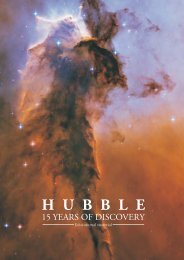PDF File - ESA/Hubble
PDF File - ESA/Hubble
PDF File - ESA/Hubble
You also want an ePaper? Increase the reach of your titles
YUMPU automatically turns print PDFs into web optimized ePapers that Google loves.
HEIC0502: FOR RELEASE 20:00 (CET)/2:00 PM EST 12 January, 2005Photo release:<strong>Hubble</strong> finds infant stars in neighbouring galaxy12-January-2005 <strong>Hubble</strong> astronomers have uncovered, for the first time, apopulation of infant stars in the Milky Way satellite galaxy, the Small MagellanicCloud (SMC, visible to the naked eye in the southern constellation Tucana),located 210,000 light-years away.The exquisite sharpness of the NASA/<strong>ESA</strong> <strong>Hubble</strong> Space Telescope has plucked out anunderlying population of infant stars embedded in the nebula NGC 346 that are stillforming from gravitationally collapsing gas clouds. They have not yet ignited theirhydrogen fuel to sustain nuclear fusion. The smallest of these infant stars is only half themass of our Sun.Although star birth is common within the disk of our galaxy, this smaller companion galaxyis more primeval in that it lacks a large percentage of the heavier elements that are forgedin successive generations of stars through nuclear fusion.Dwarf galaxies like the SMC are considered primitive building blocks of larger galaxies.Most of these types of galaxies existed far away, when the universe was much younger.The SMC offers a unique nearby laboratory for understanding how stars arose in the earlyuniverse. Nestled among other starburst regions with the small galaxy, the nebula NGC346 alone contains more than 2,500 infant stars.The <strong>Hubble</strong> images, taken with the Advanced Camera for Surveys, identify three stellarpopulations in the SMC region of NGC 346 – a total of 70,000 stars. The oldest populationis 4.5 billion years, roughly the age of our Sun. The younger population arose only 5million years ago (about the time Earth’s first hominids began to walk on two feet).Curiously, these infant stars are strung along two intersecting dust lanes in the nebula,resembling a "T" pattern in the <strong>Hubble</strong> plot. The stars behind these lanes are colouredreddish-brown due to the effect of reddening caused by the dust.The observations, by Antonella Nota of the European Space Agency (<strong>ESA</strong>) and the SpaceTelescope Science Institute (STScI), Baltimore, USA, are being presented today at themeeting of the American Astronomical Society in San Diego, California, USA.The image was composed from two individual exposures taken through a V filter (555 nm,shown in blue) and a near-infrared filter (814 nm, shown in red).# # #1
Notes for editorsThe other science team members are: M. Sirianni (STScI/<strong>ESA</strong>), E. Sabbi (Univ. ofBologna), M. Tosi (INAF - Bologna Observ.), J.S. Gallagher (Univ. of Wisconsin), M.Meixner (STScI), M. Clampin (GSFC), S. Oey (Univ. of Michigan), A. Pasquali (ETH Zurich),L. Smith (Univ. College London), and R. Walterbos (New Mexico State Univ.).The <strong>Hubble</strong> Space Telescope is a project of international cooperation between <strong>ESA</strong> andNASA.Image credit: NASA, <strong>ESA</strong> and A. Nota (STScI/<strong>ESA</strong>)For more information, please contact:Antonella Nota<strong>ESA</strong>/Space Telescope Science Institute, USATel: +1-410-338-4520E-mail: nota@stsci.eduMarco Sirianni<strong>ESA</strong>/Space Telescope Science Institute, USATel: +1-410-338-4810E-mail: sirianni@stsci.eduLars Lindberg Christensen<strong>Hubble</strong> European Space Agency Information Centre, Garching, GermanyTel: +49-(0)89-3200-6306Cellular: +49-(0)173-3872-621E-mail: lars@eso.org2








